A sedentary lifestyle, typical of most modern people, often leads to diseases of the musculoskeletal system. One of them is cervical osteochondrosis. Recently, this disease has become much younger and its symptoms are often found in people over the age of 25. If left untreated, the pathology can have dangerous consequences.
Causes of pathology

The main cause of cervical osteochondrosis is the wrong distribution of load on the spine. The factors that lead to this may be different. Let's say a person is used to carrying a heavy bag on one shoulder, sleeping or sitting in the wrong position, etc. It seems that these factors are insignificant, but when they act for a long time, they lead to a completely logical consequence - osteochondrosis of the cervical spine.
The risk factors that increase the probability of pathology are the following:
- over weight;
- lack of physical activity;
- spinal injury transfer;
- posture disorders;
- foot pathology;
- impaired blood supply to the cervical spine.
These reasons lead to the formation of an incorrect position of the vertebrae. Weight is distributed unevenly on the vertebrae, so some parts of the cervical spine are under excessive stress. In response to this, changes occur in the tissues.
The following factors can also aggravate the situation:
- the transfer of a serious illness or injury that leads to exhaustion of the body;
- constant stress;
- metabolic disorders in the body;
- insufficient use of trace elements, their excessive consumption or insufficient absorption by the intestines;
- occupational diseases (in particular vibration diseases);
- genetic predisposition to osteochondrosis;
- scoliosis and other postural disorders;
- non-compliance with the drinking regime;
- improper nutrition;
- bad habits;
- the pregnancy.
Most often, SHOX causes a complex of factors. In its appearance, lifestyle, general health and the presence of underlying pathologies play a role.
Symptoms of the disease.
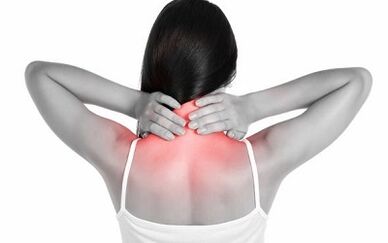
Even in the initial stage, it can be recognized by the following symptoms:
- pain in the neck, back of the head, arms, shoulders;
- weakness of the upper extremities;
- headaches and cracking sounds;
- general weakness and fatigue;
- frequent dizziness;
- lack of coordination;
- numbness of the tongue, hearing and vision problems.
The most common symptom is dizziness. It can be accompanied by:
- ringing and noise in the ears;
- migraines
- nausea and vomiting.
Headaches are often suffered by patients, especially women. Sometimes it manifests:
- anxiety;
- irritability;
- constant mood swings;
- sleep disorders.
How is a problem in this part of the spine diagnosed?
SHOX is diagnosed by the following methods:
- Bone scan. This method is not always effective, especially in the later stages of the pathology.
- Magnetic resonance. It allows you to see bone structures, hernias, their size and direction of development.
- CONNECTICUT. Computed tomography is less effective than MRI, since hernias and their size are difficult to determine with this method.
- Ultrasonic duplex scanning. This method is used if there is a suspicion of disturbed blood flow in the arteries. The scan allows evaluating the speed of blood flow and the presence of obstacles to it.
Peculiarities
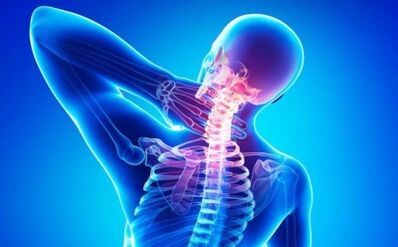
The disease can develop in different ways. Sometimes it is compensated, sometimes exacerbations appear.
Along with the pathological process, compensation mechanisms are triggered, prolonging the functions of the vertebrae for a time and eliminating symptoms. But with the subsequent course of the disease leads to the destruction of the fibrous ring and the appearance of microcracks. The vertebrae lose fixation and stability.
Also, osteochondrosis is characterized by the impregnation of the pulp of the space between the vertebrae with calcium. In view of this, a kind of hernia is formed, as the affected vertebra is pressed against the body of the person next to it.
The structures wear out over time, resulting in massive ossification.
Stages
The course of the disease is divided into several stages:
- Level 1.Instability of the structures of the vertebrae and alterations in the discs.
- Stage 2.Decreased fixation of vertebral sections, disc protrusion.
- Stage 3.Rupture of the annulus fibrosus, obvious symptoms and pain.
- Stage 4.Difficulty of movement, severe acute pain, scattered bone tissue.
Due to the peculiarities of the location of blood vessels and muscles, the neck is vulnerable areas. With a long course of osteochondrosis, numerous complications arise, many of which pose a serious danger to human health.
How to give first aid at home?
Treatment of cervical osteochondrosis at home includes:
- medicines;
- physiotherapy;
- massage;
- recovery gymnastics;
- diet correction.
It is in combination that the methods of therapy allow to achieve good results in the treatment of cervical osteochondrosis. Symptoms of the disease can cause serious discomfort, so you need to know how to give first aid.
Medicines
Various medications are used to combat the symptoms of the disease. They must be prescribed by a doctor who specializes in the treatment of osteochondrosis - a neurologist or a vertebrologist.
Medicines

- For severe pain, you can take pain relievers. If they don't work, NSAIDs can be taken.
- Sometimes "distractions" are used, such as a pepper patch. By itself, it does not heal, but it warms the inflamed area and relieves pain.
- For edema in the area of inflammation, herbal teas and diuretics are useful.
For the treatment of SHOC, the following groups of drugs are prescribed:
- Non-steroidal anti-inflammatory drugs. Helps relieve pain, swelling, and inflammation of the affected nerve root.
- Vitamins of group B. They help to improve metabolic processes in nervous tissues.
- Chondroprotectors. It favors the restoration of cartilage tissue.
- Muscle relaxants. Helps reduce muscle spasms.
- Medicines intended to improve the rheological properties of blood flow and blood. They help improve the process of blood flow to the brain and the nutrition of the affected nerve endings.
Intramuscular injections may also be indicated.
Ointments
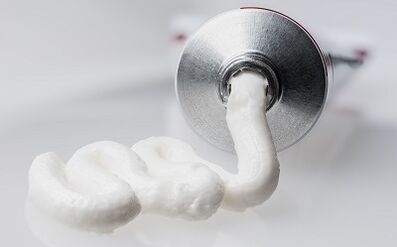
Ointments for osteochondrosis help to eliminate unpleasant symptoms at the initial stage of the pathology. They are classified according to the effect on the body:
- Anti-inflammatory.The preparations contain non-steroidal anti-inflammatory substances that help eliminate pain and improve capillary permeability, reduce inflammation, swelling and redness.
- Heating.Such ointments have various contraindications, but in some cases they are very effective.
- Complex preparations.Means of this group relieve pain and inflammation, have antithrombotic and antimicrobial effects. Instantly penetrate the tissues of the joints, normalizing blood flow.
- Products of plant origin.The advantage of such ointments is the naturalness of the composition. But you need to use them for a long time.
- Chondroprotectors.Means of this type protect cartilage tissue from negative factors. Ointments include chondroitin, glucosamine. They activate tissue repair processes and reduce inflammation. It is recommended to use them 2-3 times a day, having previously massaged the neck area a little.
Massage

Massage helps strengthen muscle tone and relieve pain. His technique is selected according to the stage of the disease. But in most cases all the classic massage techniques are used: rubbing, stroking, kneading, etc.
- If the patient's pain occurs on only one side, the massage begins from a healthy area, gradually moving to where the pain occurs.
- The first session should not last more than seven minutes. Then each procedure is increased by 1-2 minutes until the session time reaches 12 minutes.
- The patient should be placed in the prone position, placing the forehead on the cysts and arms and stretching the chin towards the chest. It is important that the neck muscles are relaxed.
On your own
Massage can be done at home, but in this case, you need to be very careful not to injure yourself further. Self-massage with SHOX includes the following classic techniques:
- Stroking.The massage begins by stroking the neck area in the direction of the lymph to the axillary and supraclavicular nodes. Next, caresses of the planar and comb-shaped order are performed.
- Lizards.The hand is placed across the neck and moves down the spine. Push-ups can also be performed with the edge of the palm toward the shoulder joints.
- Rubbing.Made to warm up and relax the muscles. The massage begins at the base of the skull. Straight and circular movements are done with the fingers. Sawing motions can also be performed with the palms parallel to the ribs.
- Kneading.The neck is stretched in a circular motion.
- Vibration.The massage ends with caresses and vibrations that are carried out by shaking and tapping.
Physiotherapy
Corrective gymnastics helps to improve the patient's condition. But it will be safer during the recovery period. During the performance, the patient should not feel pain or discomfort. The exercises are intended to strengthen the neck muscles.
Complex exercise therapy
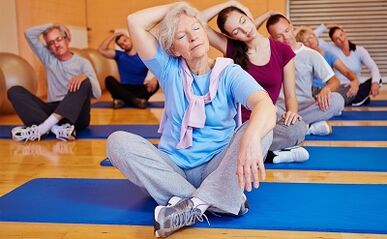
The gymnastics complex must be selected by a doctor. The following exercises are helpful:
- In the prone position, you should rest your hands on the floor and slowly raise your head, keeping your back and torso straight. In the top position, you need to stop for a couple of minutes, and then gently return to the starting position. Do 2-3 reps.
- You need to take a lying position on your stomach, stretch your arms along the body. The head turns first to the left, then to the right. Try to touch the ground with your ear. For each side, at least 6 repetitions are performed.
- In a sitting position, when inhaling, you should bend over to touch your chest with your chin, then when exhaling, lean back, throwing your head back. The number of repetitions is 10 to 15.
- You should press your forehead with the palms of your hands and resist them with your forehead for 30 seconds. The exercise is then repeated by applying pressure to the back of the head with the hands together. The number of repetitions is 2-3.
- Gentle rotations of the head are made to the sides, 10 times each. Dizziness should be avoided during this exercise.
Complementary therapy
Treatment can be supplemented with physiotherapy methods, as well as the use of various devices such as massagers.
Massagers
The use of massagers helps speed recovery. It should be noted that they have a number of contraindications and can only be used with the permission of a doctor. With osteochondrosis of the cervical spine, it is often used:
- applicator;
- warming massagers;
- neck and shoulder devices.
Applicator
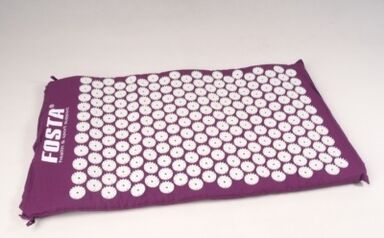
The applicator is a pillow or mat with plastic or metal spikes.
It acts on specific points that respond to all the biological processes of the organism.
The use of the product helps to achieve the following results:
- reduction or elimination of pain;
- improvement of metabolic processes in cells;
- elimination of joint tension and restoration of its tone;
- normalization of sleep.
The device must be used in accordance with the instructions.
Physiotherapy
The following methods may be indicated from physiotherapy for SHH:
- Electrophoresis. . . It is combined with medications that immediately enter the desired area by the effect of an electric current.
- Ultrasound.Relieves pain and inflammation, helps improve metabolic processes.
- Magnetotherapy.Relieves tissue swelling, thus minimizing pain.
- Laser therapy.Eliminate inflammation and improve blood circulation.
Home remedies
Time-tested folk recipes can be used as an additional treat.
Kerosene compress
A hot compress with kerosene helps to quickly relieve pain.
- The cloth should be moistened with a solution, applied to the affected area.
- Put a cotton or plastic wrap on top.
- Hold for no more than three hours.
Rubbing of pharmaceutical preparations
- You need to crush 5 analgin tablets.
- Add 15 ml of centrifuge, 0. 005 l of iodine and camphor alcohol, mix well.
- The composition is rubbed into the areas of the neck where pain is noticeable.
Pine bud infusion

The infusion of pine into the kidneys allows for a minimum period of time to obtain a long-term remission in case of pain in the cervical spine due to osteochondrosis.
This drug will have to be prepared in advance and consumed for quite a long time, but the results will bring the long-awaited effect for many months.
preparation:
- The buds must be harvested before May. They are cut into circles, placed in a glass container and covered with granulated sugar in a 1: 2 ratio.
- The drug must be infused for two weeks.
- You need to take it at 0, 0005 liters three times a day, keeping it in your mouth for a while and only then swallowing it.
The admission course is 2-3 weeks.
Potato compress
- You need to mix 50 g of grated raw potatoes with the same amount of honey.
- The composition is applied on a piece of natural fabric and placed on the neck.
You can get rid of the pain in three days.
Radish dressing
- Radish should be grated on a fine grater.
- Place the porridge between two thin pieces of cloth and place it around the neck, wrapping it with aluminum foil or parchment.
- You can keep it as long as there is enough time and effort.
Honey bandage
- You need to mix 15 grams of honey and chopped salt.
- The composition is applied to a piece of natural material and placed on the affected area.
- On top you must close it with paper and wrap it with something warm.
Repeat the procedure every night.
Coniferous broth
- 250 grams of young pine or fir needles should be poured with one liter of water.
- Cook for half an hour.
- The liquid is consumed twice a day, 35 minutes after meals.
The course of therapy lasts one month.
Dandelion broth
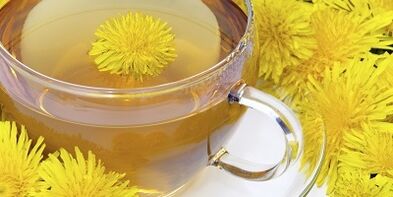
The most important medicinal properties of dandelion are associated with the content of inulin, a large number of amino sugars, natural rubber.
The plant is also valued for the content of taraxacin glucoside, triterpenic compounds, fatty oil, organic acids and alcohols, resinous compounds, bioflavonoids, as well as a number of mineral compounds, including necessary calcium.
preparation:
- You need to grind the dandelion roots to get 15 grams of the product.
- It is poured over 250 ml of hot water and left in a boiling water bath for 15 minutes.
- The broth should be infused for 55 minutes, then strain and add water until it regains its original volume.
- Consume 75 ml three times a day before meals.
Ginger salve
- Grind the ginger root, which weighs about 55 g.
- Add 30 ml of softened butter and 3 cloves of garlic.
- The agent is applied to the affected area to warm it.
Mustard Egg Mix
You need to mix:
- 50 g of mustard powder;
- 3 beaten egg whites;
- 50 ml of camphor alcohol;
- 59 ml of vodka or medical alcohol.
The product is infused in a dark place for 10-12 hours.
To prepare the second mixture, you need to mix:
- 100 g of honey;
- 50 g of aloe juice;
- 150 ml of vodka or diluted alcohol.
The composition is placed in a dark place for 12 hours.
The funds are applied twice a day, applying to the affected area and staying there until dry. It is recommended to combine them until they are exhausted. A 12-day course will help you forget about pain for several months.
What to do in case of severe pain?
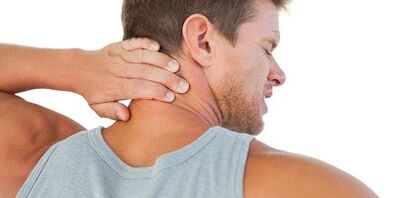
- For severe pain, you can take an anesthetic or NSAIDs. The ointments give a quick result.
- The affected department must have peace.
- Hot or cold compresses also help. In this case, moderation is important so that the effects of high or low temperatures do not increase pain and swelling.
It should be noted that the therapy of osteochondrosis should be carried out in a complex.
First of all, you need to eliminate all pain in the neck and head, eliminate the root causes that cause discomfort.
If the patient treats extremely severe pain, it will not be possible to get rid of the main problem.
Dizziness relief
- When dizziness occurs, the patient should be lying down or sitting so that the neck is as relaxed as possible.
- In case of fainting, place the patient in a horizontal position and tilt the head down.
Medicines help:
- muscle relaxants;
- vasodilators;
- anti-inflammatory and pain reliever medications.
Gymnastics and physical therapy are also helpful in treating vertigo.
Prevention of exacerbations.
To prevent exacerbations, it is important to follow the following recommendations:
- Moderate exercise is helpful. They help improve blood circulation and lymphatic flow in the neck area, improve the mobility of the vertebrae and prevent degenerative changes.
- Nutrition plays an important role. A special diet is not required, but it is recommended to limit the use of salty and spicy foods, sugar, foods containing artificial ingredients. The diet should contain enough protein, vitamins, minerals, and plant fiber. Drinking lots of water is also important.
- It is necessary to undergo regular check-ups by an orthopedist.
- If you are overweight, you need to get rid of it.
- When carrying weights, you must evenly distribute the load.
- People who work on the computer should do a periodic warm-up.
- It is important that you control your posture, try to avoid stress, injury and hypothermia.
Advice from doctors and patients

Specialists and patients with osteochondrosis of the cervical spine also give the following advice:
- For acute pain, don't self-medicate. It is necessary to consult a doctor as soon as possible, who will develop a comprehensive treatment regimen, taking into account a specific case.
- You should not try to correct the displaced vertebra on your own and take a large amount of pain relievers. Self-medication can only aggravate the condition.
- An important measure for the exacerbation of osteochondrosis is the motor regime. In the early days, rest and restriction of movement are needed, but in the future, motor activity should expand. Special exercises are helpful.
- It is important to stop smoking. This applies to both the treatment of the disease and its prevention. Due to the influence of cigarette smoke, blood vessels are affected, blood circulation worsens, and metabolic processes slow down. As a result, the risk of developing degenerative processes in various parts of the spine increases.
The symptoms of cervical osteochondrosis are quite unpleasant. If they appear abruptly and cause severe discomfort, you can use first aid measures in the form of pain relievers or folk remedies. But it should be understood that these methods only alleviate the condition, but do not cure the disease. To get rid of osteochondrosis, you need to visit a specialist and adhere to the complex treatment regimen prescribed by him.

























